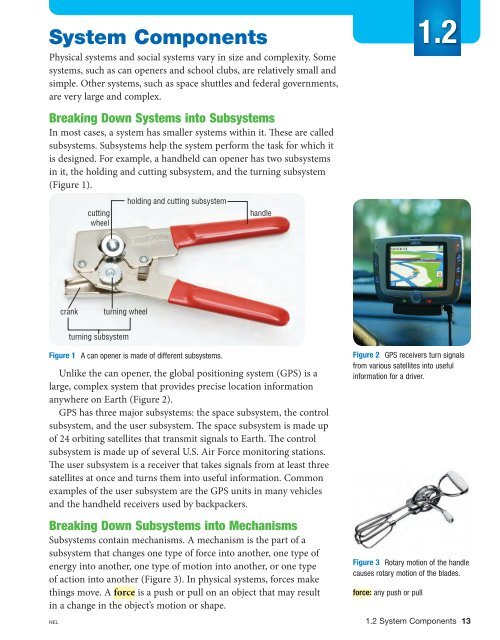Student Book Sample Pages - Nelson Education
Student Book Sample Pages - Nelson Education
Student Book Sample Pages - Nelson Education
You also want an ePaper? Increase the reach of your titles
YUMPU automatically turns print PDFs into web optimized ePapers that Google loves.
System Components<br />
Physical systems and social systems vary in size and complexity. Some<br />
systems, such as can openers and school clubs, are relatively small and<br />
simple. Other systems, such as space shuttles and federal governments,<br />
are very large and complex.<br />
Breaking Down Systems into Subsystems<br />
In most cases, a system has smaller systems within it. These are called<br />
subsystems. Subsystems help the system perform the task for which it<br />
is designed. For example, a handheld can opener has two subsystems<br />
in it, the holding and cutting subsystem, and the turning subsystem<br />
(Figure 1).<br />
cutting<br />
wheel<br />
holding and cutting subsystem<br />
handle<br />
1.2<br />
crank<br />
turning wheel<br />
turning subsystem<br />
Figure 1 A can opener is made of different subsystems.<br />
Unlike the can opener, the global positioning system (GPS) is a<br />
large, complex system that provides precise location information<br />
anywhere on Earth (Figure 2).<br />
GPS has three major subsystems: the space subsystem, the control<br />
subsystem, and the user subsystem. The space subsystem is made up<br />
of 24 orbiting satellites that transmit signals to Earth. The control<br />
subsystem is made up of several U.S. Air Force monitoring stations.<br />
The user subsystem is a receiver that takes signals from at least three<br />
satellites at once and turns them into useful information. Common<br />
examples of the user subsystem are the GPS units in many vehicles<br />
and the handheld receivers used by backpackers.<br />
Breaking Down Subsystems into Mechanisms<br />
Subsystems contain mechanisms. A mechanism is the part of a<br />
subsystem that changes one type of force into another, one type of<br />
energy into another, one type of motion into another, or one type<br />
of action into another (Figure 3). In physical systems, forces make<br />
things move. A force is a push or pull on an object that may result<br />
in a change in the object’s motion or shape.<br />
NEL<br />
Figure 2 GPS receivers turn signals<br />
from various satellites into useful<br />
information for a driver.<br />
Figure 3 Rotary motion of the handle<br />
causes rotary motion of the blades.<br />
force: any push or pull<br />
1.2 System Components 13

















